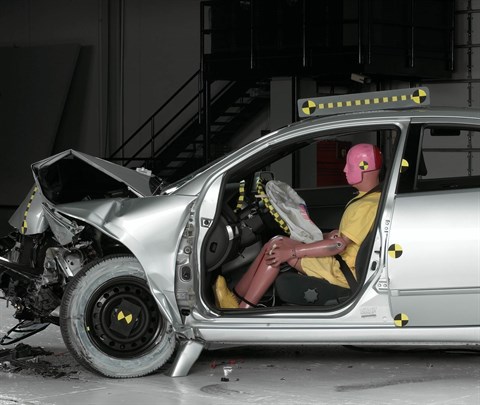Moderate overlap front: original test
Rating applies to 2004-12 models
Tested vehicle: 2004 Mitsubishi Galant ES 4-door
The Mitsubishi Galant was redesigned for the 2004 model year.
| Evaluation criteria | Rating |
|---|---|
| Overall evaluation | |
| Structure and safety cage | |
| Driver injury measures | |
| Head/neck | |
| Chest | |
| Leg/foot, left | |
| Leg/foot, right | |
| Driver restraints and dummy kinematics | |

Action shot taken during the frontal offset crash test.

The dummy's position in relation to the steering wheel and instrument panel after the crash test indicates that the driver's survival space was maintained well.

Smeared greasepaint indicates where the dummy's head hit the B-pillar and head restraint during rebound. Head accelerations from these hits were low.

Forces on the lower right leg were high enough to indicate the possibility of injuries.
Side: original test
Rating applies to 2007-12 models
Tested vehicle: 2008 Mitsubishi Galant ES 4-door with standard front and rear head curtain airbags and standard front seat-mounted torso airbags
The Mitsubishi Galant was redesigned for the 2004 model year. Front seat-mounted combination head and torso side airbags were made standard for the 2005 model year. Beginning with 2007 models, front and rear head curtain airbags and front seat-mounted torso airbags became standard.
| Evaluation criteria | Rating |
|---|---|
| Overall evaluation | |
| Structure and safety cage | |
| Driver injury measures | |
| Head/neck | |
| Torso | |
| Pelvis/leg | |
| Driver head protection | |
| Rear passenger injury measures | |
| Head/neck | |
| Torso | |
| Pelvis/leg | |
| Rear passenger head protection | |

View of the vehicle and barrier just after the crash test.

View of the vehicle after the crash with doors removed, showing the side airbags and damage to the occupant compartment.

Smeared greasepaint shows where the driver dummy's head was protected from being hit by hard structures by the side curtain airbag.

Smeared greasepaint shows where the rear passenger dummy’s head was protected by the side airbag.
Roof strength
Rating applies to 2004-12 models
Tested vehicle: 2009 Mitsubishi Galant ES 4-door
| Overall evaluation | |
|---|---|
| Curb weight | 3,438 lbs |
| Peak force | 13,107 lbs |
| Strength-to-weight ratio | 3.81 |
Head restraints & seats
Seat type: Cloth seats
| Overall evaluation | |
|---|---|
| Dynamic rating | |
| Seat/head restraint geometry |
Seat type: Leather seats
| Overall evaluation | |
|---|---|
| Dynamic rating | |
| Seat/head restraint geometry |
About the head restraint & seat test
Currently, IIHS tests apply only to front seats.
